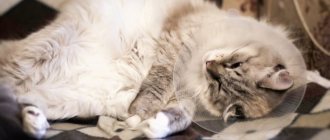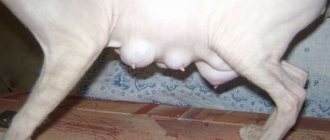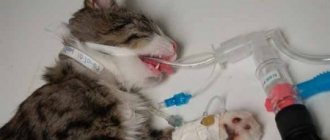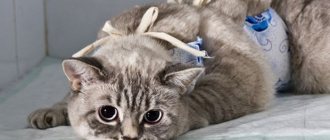- Cats
- General issues
More and more often, owners ask themselves the question: “Should I sterilize my cat?” And this approach is more correct than the use of hormonal contraceptives or a complete refusal to regulate sexual activity. The fact is that medications negatively affect the cat’s health, can lead to various tumors, etc. And in the second case, there is a threat that the animal will become pregnant several times a year. Neutered cats walk around and do not produce any offspring. The operation eliminates all questions and problems once and for all.
Reasons for sterilization
Usually, a breeder does not think about a procedure that will deprive a cat of the opportunity to become a mother immediately after purchasing a kitten, which touches with its childish carefreeness. However, as the animal gradually matures, its behavior changes, and some of its characteristics may prompt the owner to carry out this procedure. The main reasons for sterilization are:
- Health risks associated with pregnancy and childbirth,
- The uncertainty of the fate of newborn kittens,
- Cats, like cats, mark their territory with urine,
- Prevention of cancer and infectious diseases of the genital area,
- Excited behavior of an animal during estrus.
It is the last factor that has the greatest influence on breeders, since the cat’s behavior after puberty turns a quiet kitten into a meowing and purring cat around the clock, and this will continue for 1-2 weeks, or until pregnancy occurs. This behavior is formed by ancient instincts of attracting a male, and only a change in the hormonal background after sterilization can correct this situation.
Pet behavior after anesthesia
The behavior of a domestic cat directly depends on the anesthesia that was used to remove the ovaries.
There are three types of anesthesia used for sterilization:
- Anesthesia using gas. The most effective method of general anesthesia. The cat comes to its senses almost immediately after removing the anesthesia mask, its behavior differs little from its usual. It is used quite rarely due to the high cost and lack of necessary equipment in many veterinary clinics.
- Muscle relaxants in combination with epidural anesthesia. The described anesthesia is easily tolerated by animals; complete recovery from it can take up to eight hours. Experts note the risk of complications after surgery performed with this anesthesia. These include impaired sensitivity and motor activity of the hind legs. Complete normalization of the condition may take up to two days.
- Muscle relaxants together with analgesics. The most commonly used type of anesthesia, the recovery period after which can reach six days. These days, the cat sleeps a lot, there is a weak appetite, disturbances in the functioning of the vestibular apparatus, and there may be vomiting and problems with stool.
It is necessary to carefully monitor changes in the animal’s habitual habits and, if the condition worsens, consult a veterinarian. On the first day after surgery, the cat may be under the influence of anesthesia.
Your pet's behavior after recovery from anesthesia may include the following:
- impaired coordination of movements, unsteady gait, inhibited reflexes;
- aggressive behavior or, on the contrary, complete indifference;
- inappropriate reaction to people;
- complete refusal of food and liquid;
- disorientation in space;
- constant attempts to hide in a dark corner;
- frequent vomiting and uncontrolled urination;
- strong meowing.
Important! Experts note that spaying does not have a negative effect on the cat’s brain activity and helps to increase life expectancy.
Immediately after anesthesia, the cat shits on the floor
In any case, this simple operation requires anesthesia. It takes a long time for the cat to recover from it and therefore they simply do not realize that they are not using the litter box, but are defecating in another place. Under no circumstances should you be punished for this.
First of all, you should choose the type of food: natural food or canned food. Remember that these two types of diet should not be mixed. Either you feed your cat natural products, or you give him ready-made industrial products.
In the second case, you can add several recommendations:
- There are foods for different breeds and ages, try to choose the one that suits you best.
- The portion is calculated based on the weight or size of the cat. The average size is considered to be an animal weighing 4-5 kg.
- The packaging may indicate a daily portion or a single portion (with double feeding), the main thing here is not to confuse it.
- When feeding industrial dry food, it is necessary to provide the cat with water.
When feeding a cat naturally, you can feed the following foods:
- lean meat;
- liver;
- lung, heart;
- eggs;
- cottage cheese;
- vegetables;
- porridge and vegetables.
A cat’s behavior after sterilization can change dramatically or be practically the same as usual - this directly depends on the age, the anesthesia chosen and the individual characteristics of the pet. Most often, owners decide to spay a cat due to constant screaming and changes in behavior for the worse.
A pet's heat can last from one day to a couple of weeks and repeat several times a year. Refusal of surgery and use of sedatives can negatively affect the health of the pet. The risk of pyometra increases with each year of a cat's life.
In turn, many cat owners fear that after this procedure their pet will become lethargic and become very fat, and the general condition of the animal’s body will also worsen.
To obtain the most harmless and high-quality result, before surgery it is necessary to consult a qualified specialist and select anesthesia taking into account these tests.
The behavior of a domestic cat directly depends on the anesthesia that was used to remove the ovaries.
There are three types of anesthesia used for sterilization:
- Anesthesia using gas. The most effective method of general anesthesia. The cat comes to its senses almost immediately after removing the anesthesia mask, its behavior differs little from its usual. It is used quite rarely due to the high cost and lack of necessary equipment in many veterinary clinics.
- Muscle relaxants in combination with epidural anesthesia. The described anesthesia is easily tolerated by animals; complete recovery from it can take up to eight hours. Experts note the risk of complications after surgery performed with this anesthesia. These include impaired sensitivity and motor activity of the hind legs. Complete normalization of the condition may take up to two days.
- Muscle relaxants together with analgesics. The most commonly used type of anesthesia, the recovery period after which can reach six days. These days, the cat sleeps a lot, there is a weak appetite, disturbances in the functioning of the vestibular apparatus, and there may be vomiting and problems with stool.
It is necessary to carefully monitor changes in the animal’s habitual habits and, if the condition worsens, consult a veterinarian.
On the first day after surgery, the cat may be under the influence of anesthesia.
Your pet's behavior after recovery from anesthesia may include the following:
- impaired coordination of movements, unsteady gait, inhibited reflexes;
- aggressive behavior or, on the contrary, complete indifference;
- inappropriate reaction to people;
- complete refusal of food and liquid;
- disorientation in space;
- constant attempts to hide in a dark corner;
- frequent vomiting and uncontrolled urination;
- strong meowing.
Important! Experts note that spaying does not have a negative effect on the cat’s brain activity and helps to increase life expectancy.
After sterilization, it is better to place the cat in a cage.
Whether a pet's behavior changes directly depends on several factors:
- type of surgical intervention - planned or emergency;
- age of the cat at the time of sterilization;
- type of anesthesia.
The first day after sterilization, the cat can be quite aggressive, biting and scratching. This is a consequence of a pronounced reaction to the noise around her, as well as to a large number of people around. It is recommended to leave the animal alone for a short time in a room with dim lights or only in the presence of the owner. It is not advisable to allow children near your pet.
In addition, changes in behavior may occur due to pain after recovery from anesthesia.
The main signs indicating the presence of pain can be identified:
- strong aggression when trying to stroke or pick up;
- dilated pupils for a long time;
- concentrated gaze at one point, lack of response to the owner’s call;
- staying motionless in one position for a long time - most often cats lie on their stomachs and tuck their paws under them.
Most animals try to remove the post-operative bandage; care must be taken to ensure that the pet does not do this and injure itself.
On the second day, the cat can already move around and eat.
On the second day after sterilization, in most cases, normal appetite and thirst return. The cat becomes more active, eats and drinks on its own, and the functioning of the digestive tract is normalized. If you completely refuse to eat for several days, you should be examined by your doctor.
You should not give food in large doses - the hormonal background of the animal changes after removal of the ovaries, which can lead to obesity. Also, if your pet has been constipated for three days, it is necessary, after consulting a doctor, to give him a laxative, such as Vaseline oil.
Complete normalization of behavior in a sterilized animal is observed after a month. In addition, after this period of time after the operation, the animal’s hormonal levels stabilize. The main change is that the cat becomes calmer and more affectionate, and is less likely to be alone.
We invite you to read: After sterilization, a cat asks for a cat and continues to mark: reasons for how to help your pet
After a month, the consequences of the operation are almost negligible.
If you follow all the recommendations of the attending physician, stabilization of the condition occurs much earlier - after just a few weeks, the animal’s habits can become completely familiar, and the pet itself will return to a playful mood, since it will no longer be disturbed by sexual instincts. The animal stops marking its territory, and the smell of urine becomes less pronounced.
Attention! In most cases, sterilization has virtually no effect on changing the animal’s habitual behavior. However, in the event of prolonged excessive aggression, additional treatment must be carried out in consultation with a veterinarian.
To minimize the risk of deterioration in the cat’s health and avoid negative changes in behavior, it is recommended to contact highly qualified specialists with sufficient experience to perform the operation. It is important to remember that each animal has its own character, and changes in behavior after surgery directly depend on the individual characteristics of the cat.
The video describes in detail the behavior and care of a cat in the first days after sterilization:
- Anesthesia using gas. The most effective method of general anesthesia. The cat comes to its senses almost immediately after removing the anesthesia mask, its behavior differs little from its usual. It is used quite rarely due to the high cost and lack of necessary equipment in many veterinary clinics.
- Muscle relaxants in combination with epidural anesthesia. The described anesthesia is easily tolerated by animals; complete recovery from it can take up to eight hours. Experts note the risk of complications after surgery performed with this anesthesia. These include impaired sensitivity and motor activity of the hind legs. Complete normalization of the condition may take up to two days.
- Muscle relaxants together with analgesics. The most commonly used type of anesthesia, the recovery period after which can reach six days. These days, the cat sleeps a lot, there is a weak appetite, disturbances in the functioning of the vestibular apparatus, and there may be vomiting and problems with stool.
It is necessary to carefully monitor changes in the animal’s habitual habits and, if the condition worsens, consult a veterinarian. On the first day after surgery, the cat may be under the influence of anesthesia.
- impaired coordination of movements, unsteady gait, inhibited reflexes;
- aggressive behavior or, on the contrary, complete indifference;
- inappropriate reaction to people;
- complete refusal of food and liquid;
- disorientation in space;
- constant attempts to hide in a dark corner;
- frequent vomiting and uncontrolled urination;
- strong meowing.
Upon arriving home after the veterinary clinic, a moment of shock comes for the cat's owners. They will have to watch their animal for a long time and help it survive this difficult period. A cat may fall when standing on its paws, it may not eat or drink well, it may become entangled in wires or be injured when bumping into a corner.
To prevent this from happening, you need to remove all dangerous objects, place the cat on low furniture and place bowls of water, food and a tray near it. Try to protect the operated animal from children and other pets. The cat after the sterilization operation is still very weak; if it cannot drink on its own, water can be given to it from a pipette.
A few drops are enough, the main thing is to moisten your mouth and throat. It is better to organize a temporary warm bed for your pet, away from drafts. It is necessary to lay her on her right side, otherwise the load on the heart will increase several times. Do not be afraid of the animal’s unusual behavior. It is necessary to ensure that the animal sleeping after anesthesia does not choke on vomit.
How does a cat's behavior change after sterilization?
Many pet owners wonder whether cats need sterilization. And if necessary, how will the operation affect the cat’s subsequent behavior and health?
Usually, owners decide to undergo this operation when the cat becomes aggressive and constantly yells. The operation involves removing the ovaries. After sterilization, the cat does not suffer from constant attraction to the opposite sex. The operation can be performed at any veterinary clinic.
A cat's heat lasts from one day to two weeks. As a rule, this happens several times a year. If the cat is not bred, it can have a bad effect on its health. Certainly.
At the veterinary pharmacy you can buy various drops and tablets that will calm her down, but this is an additional blow to the body.
This leads to the conclusion that if it is not possible to breed a cat, then sterilization is the best way out of the situation.
It is best to sterilize a cat at the age of 6 months, before puberty. Such early sterilization can prolong the cat's life. If this stage has already been passed, then you should not have surgery during the period of excitement. A month before the operation, the animal will have to receive all required vaccinations. The cat should not be fed 12 hours before surgery. The operation is performed under general anesthesia.
Upon arrival home, after surgery, the cat must be placed on a hard surface. The room should be ventilated. Within 3 hours, the cat should finally recover from anesthesia. You should not allow your cat to run and jump immediately after she comes to her senses. You can’t feed her on this day. But clean water should be freely available.
Before the operation, it is better to do the necessary tests to identify possible intolerance to anesthesia. After surgery, inflammation is also possible.
However, unpleasant consequences can be avoided by choosing a good clinic and doctor. But do not forget that proper care after surgery is also necessary. The cat should feel the support of its owners.
If you follow all the rules, then no consequences will occur.
Changes in a sterilized cat
Since the surgery suppresses hormones, the cat will behave calmer. You will be able to forget about the cat’s night cries, her heat and aggressive behavior. Although the character itself does not change radically, just as the female behaved during the quiet period of her life, this is how she will behave.
However, veterinarians say that operated pets become more affectionate, calm and even obedient.
Changes also occur in the appearance of the fluffy beauty. After sterilization, they begin to gain excess weight. It is worth noting that if the owners feed the animal correctly (food for sterilized cats) and actively spend time with it, then this problem will disappear.
These special foods contain fiber and protein in moderation. All this contributes to good digestion and absorption of food. Therefore, you should not feed cats from the table. It is this kind of food that can ruin the figure, appearance and health of your furry beauty.
Indeed, after the operation, a furry lady may have an excellent appetite and constantly persuade you to treat her with something, but you should not succumb to her tricks. The weight of animals can only depend on their owners.
It also happens that after sterilization, a cat looks for a partner, less, but still, meows and wipes itself on everything. This may indicate that the operation was not performed by a fully qualified doctor, because if the ovaries are not completely removed, then some parts of it may continue to function and send signals.
Also, such signals can be given by the unremoved uterus, and even by its adrenal glands. In this case, the owners of a fluffy cat need to carefully monitor its behavior; if it is similar to what it had during the period of heat, then this is a clear signal to contact a specialist.
As you can see, there are very few postoperative problems. Therefore, today more and more people agree to this procedure if they do not intend to breed cat offspring. And this is precisely what helps them maintain the health of their pet, make it calmer and even prolong its life.
After sterilization, stitches are placed, which must be carefully monitored so that the cat does not scratch them. Usually it is suggested to put a blanket on the animal, which will protect the wound. Today, absorbable sutures are often applied, which help owners avoid visiting the veterinary clinic again.
In addition, it is worth noting that operated cats are more friendly to other animals, they are playful with them and calm. They do not have mood swings or causeless aggression. The maternal instinct itself disappears, so the cat will treat other people’s cubs absolutely calmly.
And don’t worry that you deprived her of something, because she won’t even understand it. Moreover, the female will not scream wildly, looking for a partner. She will completely lose sexual desire. Owners also note that cats become more attached to their owners, they shower them with affection and are not afraid to show it in public.
As for males, before castration they also show aggression in their behavior. In addition, they upset their “parents” with constant dirty corners and eternal demonstrative concerts. It is worth noting that a cat who is looking for a female may want to escape from the apartment. Therefore, after surgery, all these problems simply disappear.
The first hours after surgery
Upon arriving home after the veterinary clinic, a moment of shock comes for the cat's owners. They will have to watch their animal for a long time and help it survive this difficult period. A cat may fall when standing on its paws, it may not eat or drink well, it may become entangled in wires or be injured when bumping into a corner. To prevent this from happening, you need to remove all dangerous objects, place the cat on low furniture and place bowls of water, food and a tray near it. Try to protect the operated animal from children and other pets. The cat after the sterilization operation is still very weak; if it cannot drink on its own, water can be given to it from a pipette.
A few drops are enough, the main thing is to moisten your mouth and throat. It is better to organize a temporary warm bed for your pet, away from drafts. It is necessary to lay her on her right side, otherwise the load on the heart will increase several times. Do not be afraid of the animal’s unusual behavior. It is necessary to ensure that the animal sleeping after anesthesia does not choke on vomit.
Negative consequences
- Sterilization is an operation, so it carries certain risks . Unforeseen complications may arise as a result of a medical error or the characteristics of the animal’s body.
- The operation requires general anesthesia . The procedure of inducing anesthesia itself is not dangerous to the health of the animal, but the postoperative period is fraught with some difficulties. After sterilization, the cat is poorly oriented in space, so it can fall and get injured. In addition, in the first hours the owner must monitor the pet so that it does not choke on vomit during an attack of nausea.
- The cat requires special care in the postoperative period . For two weeks, the animal wears a special blanket, and during this time the cat should not be allowed outside - it can get caught in the string on the blanket, hang on a tree, and cause the seams to come apart. Every day the owner must treat the postoperative wound; the cat is often prescribed a postoperative course of antibiotics.
- After sterilization, a cat needs a special diet - after such an operation, animals often gain weight. To prevent excess weight from becoming the cause of various concomitant chronic diseases, you need to adjust your pet’s diet and provide her with the necessary physical activity.
- It is not possible to restore the cat's ability to bear children . If at some point the owners want kittens from their purr, they won’t be able to turn back time - they will have to buy a kitten or adopt it from a shelter.
What determines a cat’s recovery after sterilization?
Much depends on the type of deprivation:
- "Standard" cavity sterilization. In this case, the organs of the reproductive system (i.e., the uterus and ovaries) are removed through conventional abdominal surgery. To do this, the surgeon has to make an incision four centimeters or more long, through which he subsequently removes unnecessary “offal”. In any case, to perform such a surgical intervention, high-quality, powerful anesthesia is necessary. It is not surprising that it takes a long time for a cat to recover from the consequences of the latter, and the rehabilitation period is quite long.
- Laparoscopic sterilization. It is a very “mild” version of the previous type of deprivation. The idea is to use a surgical laparoscope. First, the veterinarian makes a tiny, generally speaking, incision, the length of which rarely reaches five millimeters, after which he performs an internal abdominal operation. It is performed using the same laparoscope. Already cut off organs are pulled to the hole and taken out. Sometimes this sterilization technique uses fairly mild sedatives in combination with high-quality local anesthesia. This anesthesia is tolerated extremely easily by most animals, and the rehabilitation period is very short.
- Finally, there is also hormonal (so-called “chemical”) sterilization. Its essence is the introduction into the animal’s blood of substances that suppress the cat’s reproductive function. This is done using a regular syringe. No surgery is required, and therefore no anesthesia is required. As such, there is no rehabilitation period.
Taking into account all of the above, everything listed below will apply (primarily) to classical cavity sterilization. During laparoscopy, the cat recovers very quickly, and therefore most of the recommendations below lose their sharpness and relevance.
Rehabilitation process
Full recovery of the cat’s body usually occurs in 10-15 days. There are several recommendations for care during this period:
- It is necessary to wear a postoperative blanket to protect the stitches from licking and scratching. Prevents dirt or toilet litter from entering the wound. It is recommended to purchase a blanket made of durable but breathable material. Tie tightly, but without over-tightening. The blanket should not restrict movement.
- The healing process of postoperative sutures must be monitored. Stitches can be ordinary or cosmetic. In the first case, it is necessary to remove the stitches within the time prescribed by the veterinarian. This procedure is not required with cosmetic sutures, as they are made of absorbable material. The condition of a seam can be determined by how it looks. There should be no severe redness or swelling. To prevent bacterial infection, it is necessary to treat the seam as recommended by your veterinarian.
- The room where the animal is located during the rehabilitation period must be as safe as possible. When a cat jumps onto a window sill or chair, it can get its blanket caught on protruding parts. If the seam comes apart, you will have to reapply it.
- One of the complications after surgery is bowel dysfunction (constipation). If after two to three days the cat still does not go to the toilet, you can resort to a laxative (veterinary drugs) or Vaseline oil. Lack of results is a reason to contact a veterinarian.
Complications after sterilization
Complications after sterilization in cats can occur quite rarely. They usually occur as a result of failure to comply with the necessary measures after surgery or in cases where the operation was performed by a non-professional doctor. Also, their presence may depend on the individual characteristics of the pet’s body.
The following unpleasant consequences of sterilization are identified:
- The presence of prolonged post-anesthesia hypothermia. If a cat lies motionless for a long time, and its ears and paws are cold, then in these cases it is necessary to check its body temperature. If its level is less than 37 degrees Celsius, then the animal must be placed on a warm heating pad, covered with any natural fabric and called a veterinarian;
- Signs of intra-abdominal bleeding. Be sure to carefully monitor the condition of the seam at first. If you detect traces of blood in the suture or vulva area, as well as abdominal pain or pale skin, you should immediately consult a doctor. This must be done immediately in order to have time to stop possible bleeding in the abdominal cavity. If internal bleeding is detected, the doctor will prescribe a second operation;
- Manifestations of postoperative hyperthermia. If the temperature is more than 39 degrees Celsius and lasts for three days, then in these cases you need to consult a veterinarian. But it is better to take your cat to a veterinary clinic for the necessary examinations;
- Sometimes there may be redness around the stitch, as well as swelling. If these phenomena are observed for 3-5 days, then this is not considered a deviation, but if no discharge appears from the wound area. After about 5 days, signs of redness and swelling begin to gradually disappear, but their complete disappearance occurs by the time the sutures are removed;
- In rare cases, a cat may develop a hernia after sterilization. This phenomenon occurs due to non-compliance with advice on caring for your pet after surgery;
- If your cat screams after being spayed, this may be a sign of severe pain and discomfort. This phenomenon is considered normal in the first days; pain usually subsides on the 3rd day. To alleviate your pet's condition, you can use painkillers for cats;
- Rotting of postoperative sutures. This can happen if the rules of hygiene and care after sterilization are not followed, as a result of which dirt can get into the seam area. This leads to the development of wound suppuration. In these cases, the animal must be shown to a veterinarian;
- Diarrhea or constipation in a cat after sterilization. Problems with bowel movements may be the result of anesthesia;
- After recovering from anesthesia, the pet may be lethargic and lack appetite;
- If a cat does not drink after sterilization, this is also due to the effect of anesthesia. Usually the condition returns to normal within the next day;
- If after sterilization the cat does not go to the toilet at all or does it with difficulty, then she can be given a laxative or 1 tablespoon of Vaseline oil;
- Many owners notice that their cat sleeps a lot after sterilization. At first, this condition is normal. Drowsiness after anesthesia can be observed for 12-18 hours. The main thing is to control the animal’s body temperature; it should be covered with a warm blanket. Be sure to consult your veterinarian;
- Breast enlargement or mastopathy. These manifestations may occur before or after surgery. Sterilization speeds up recovery and eliminates all symptoms of mastopathy. The main thing is to provide proper and balanced nutrition for your pet.
If you suddenly discover one or more conditions from the above list in your cat, you need to contact a veterinarian. You should not self-medicate, because it can cause serious harm to the health of the animal. The main thing is that she needs to ensure attention and full progress.
How to help your pet?
There are a number of recommendations from veterinarians for the process of cat rehabilitation at home:
- you need to put the pet on the floor, since due to impaired coordination of movements after anesthesia, it may fall from a hill;
- the cat should not lie near heating appliances - this can cause internal bleeding;
- It is worth laying down an absorbent diaper, as the cat may spontaneously urinate, defecate or vomit;
- you need to put the pet on its right side to reduce the load on the heart;
- if a cat has a weakened immune system, it needs a course of vitamins and restoratives;
- in the first hours after surgery, it is necessary to measure the cat’s temperature once an hour and carefully turn it over every half hour to avoid numbness in its paws;
- if ulcers, crusts, rashes or redness form in the suture area, consult a veterinarian;
- in case of sudden vomiting, it is necessary to turn the cat’s head to the side and make sure that it does not choke;
- to prevent licking and scratching of the stitches, as well as to protect the wound from dust and dirt, you need to put a postoperative blanket on your pet;
- stitches must be treated in accordance with the recommendations of the veterinarian.
If all recommendations are followed, the cat will recover from anesthesia easier and recover faster.
The behavior of a domestic cat directly depends on the anesthesia that was used to remove the ovaries.
There are three types of anesthesia used for sterilization:
- Anesthesia using gas. The most effective method of general anesthesia. The cat comes to its senses almost immediately after removing the anesthesia mask, its behavior differs little from its usual. It is used quite rarely due to the high cost and lack of necessary equipment in many veterinary clinics.
- Muscle relaxants in combination with epidural anesthesia. The described anesthesia is easily tolerated by animals; complete recovery from it can take up to eight hours. Experts note the risk of complications after surgery performed with this anesthesia. These include impaired sensitivity and motor activity of the hind legs. Complete normalization of the condition may take up to two days.
- Muscle relaxants together with analgesics. The most commonly used type of anesthesia, the recovery period after which can reach six days. These days, the cat sleeps a lot, there is a weak appetite, disturbances in the functioning of the vestibular apparatus, and there may be vomiting and problems with stool.
We suggest you familiarize yourself with: A cat's hair falls out in clumps until there are bald spots.
Full list It is necessary to carefully monitor changes in the animal’s habitual habits and, if the condition worsens, consult a veterinarian. On the first day after surgery, the cat may be under the influence of anesthesia.
Your pet's behavior after recovery from anesthesia may include the following:
- impaired coordination of movements, unsteady gait, inhibited reflexes;
- aggressive behavior or, on the contrary, complete indifference;
- inappropriate reaction to people;
- complete refusal of food and liquid;
- disorientation in space;
- constant attempts to hide in a dark corner;
- frequent vomiting and uncontrolled urination;
- strong meowing.
Many pet owners wonder whether cats need sterilization. And if necessary, how will the operation affect the cat’s subsequent behavior and health?
Usually, owners decide to undergo this operation when the cat becomes aggressive and constantly yells. The operation involves removing the ovaries. After sterilization, the cat does not suffer from constant attraction to the opposite sex. The operation can be performed at any veterinary clinic.
A cat's heat lasts from one day to two weeks. As a rule, this happens several times a year. If the cat is not bred, it can have a bad effect on its health. Certainly.
At the veterinary pharmacy you can buy various drops and tablets that will calm her down, but this is an additional blow to the body.
This leads to the conclusion that if it is not possible to breed a cat, then sterilization is the best way out of the situation.
It is best to sterilize a cat at the age of 6 months, before puberty. Such early sterilization can prolong the cat's life. If this stage has already been passed, then you should not have surgery during the period of excitement. A month before the operation, the animal will have to receive all required vaccinations. The cat should not be fed 12 hours before surgery. The operation is performed under general anesthesia.
Upon arrival home, after surgery, the cat must be placed on a hard surface. The room should be ventilated. Within 3 hours, the cat should finally recover from anesthesia. You should not allow your cat to run and jump immediately after she comes to her senses. You can’t feed her on this day. But clean water should be freely available.
Before the operation, it is better to do the necessary tests to identify possible intolerance to anesthesia. After surgery, inflammation is also possible.
However, unpleasant consequences can be avoided by choosing a good clinic and doctor. But do not forget that proper care after surgery is also necessary. The cat should feel the support of its owners.
If you follow all the rules, then no consequences will occur.
Postoperative suture care
Caring for a cat after sterilization involves treating the sutures. The seam must be dry and clean. Any suppuration, bloody wetting or inflammation is a reason to contact a veterinarian. In order for the seam to heal faster, it must be treated with the following drugs:
- Levomekol ointment;
- hydrogen peroxide;
- Betadine;
- Chlorhexidine;
- brilliant green.
In the first days after surgery, swelling of the suture may be noted. This is a completely normal tissue reaction to injury. Sometimes redness of the seam is observed, and the skin around it takes on a glossy appearance. Ichor (clear liquid) may appear. On average, the suture heals completely on the 10-12th day after surgery.
Sutures in cats should be removed at 7-10 days, because the threads then begin to grow into the skin. This can be done at a veterinary clinic or on your own. There is nothing complicated about this. You need to take tweezers and small scissors. The instruments are disinfected, after which you need to pull the thread with a knot with tweezers, and cut one thread with scissors. In this way, all seams are gradually removed.











